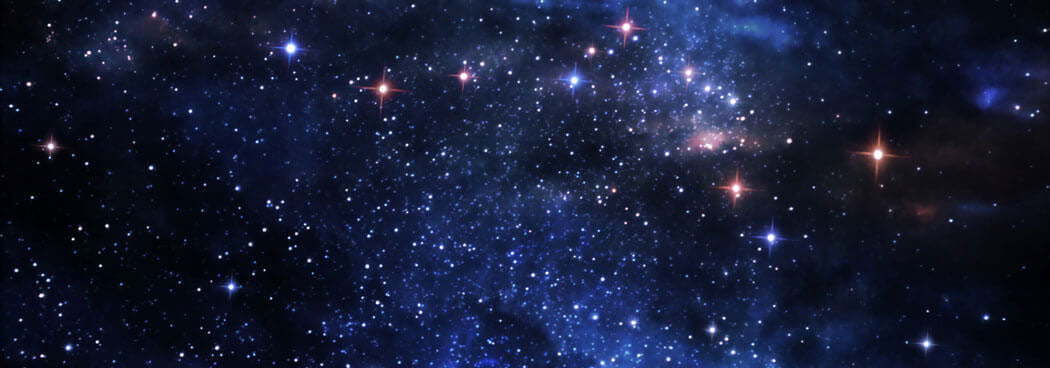
Stars: formation, colors and types
Stars are fascinating objects in the cosmos that have excited humankind for thousands of years. They are important basic building blocks of the universe and play a significant role in the origin of life on planets. They come in a variety of colors, sizes, and shapes, and observing them can reveal much about the formation and evolution of the universe. It is estimated that there are 100 billion stars in our Milky Way galaxy alone.
But what is a star, and how are they formed? Why do they shine in different colors in our night sky? And how do they differ?
What is a star and how is it formed?
A star is a cosmic object consisting of a hot, luminous mixture of gases. It is formed by collapsing a cloud of gas and dust attracted by gravitational force. When the density and temperature in the cloud are high enough, the fusion of hydrogen atoms begins in the core of the star. This process releases energy, and it begins to glow. The energy generated in the core is transported to the outside by radiation or convection.
The size and brightness of a star depend on its mass. The most massive stars have a short lifetime of only a few million years and end in an explosion as a supernova. Stars with lower mass have a longer lifetime of billions of years and end, for example, as a white dwarf or a neutron star.
Stars play an essential role in the formation of life in the universe. Without the energy they produced, it would be impossible for life to exist on planets. Some of them are also capable of forming planetary systems in which planets revolve around the star, possibly providing conditions for life. The best example is the earth, which orbits around the giant star sun.

Why do stars shine in different colors?
They shine in various colors, from white to yellow and orange to red and blue. The color also called the spectrum of light, depends on the temperature, which depends on the mass and age. Also, the distance to the earth, as well as the chemical composition, have an influence on the color.
Stars produce light through the nuclear fusion of hydrogen atoms, which fuse to form helium. This reaction generates enormous amounts of energy, which are released as light and heat. The temperature inside the star can reach several million degrees Celsius.
The hotter a star is, the bluer it appears. Blue-white shimmering stars, for example, have temperatures of up to 30,000 degrees Celsius, while red-shining stars with temperatures starting at around 1,000 degrees Celsius are considered relatively cold.
The perceivable color also depends on the distance from earth. Stars that are very far from the earth's orbit often appear redder because the light is scattered as it passes through interstellar gas and dust, which absorbs and retains the blue components of the light.
Another factor that affects color is a star's chemical composition. Elements such as hydrogen and helium produce a more comprehensive range of colors, while elements such as carbon and oxygen can change the color of stars.
What are the different types of stars?
Stars are classified based on their properties, such as size, temperature, brightness, and chemical composition. The most commonly used classification system for stars is the so-called Harvard classification system or spectral classification. This system divides them into seven main groups, designated O through M.
Group O contains the hottest and most massive stars, while group M stars are cooler and less massive. They are more common and faint. The different groups are determined by the spectral lines produced by the absorption of light by a star's atmosphere.
In addition to the Harvard classification, there are other classification systems, such as the luminosity classification system, which categorizes stars based on their brightness in conjunction with their size and distance.
As a result, there are a variety of star types. The best-known types are as follows:
Main sequence stars: These are stars like the sun. They are in the middle of their life cycle and fuse hydrogen in the core to produce helium. Most stars in the universe belong to this category. The distinctive feature is the constant and stable brightness, as well as the color of such a star. Main sequence stars are divided into dwarf stars of blue, yellow, red, and brown colors.
Giants and supergiants: Stars of this class have a much larger diameter and a more extended surface, making for a stronger luminosity. They form when stars age and run out of hydrogen in their cores. They then begin to fuse helium and expand. There are several categories of giants based on their brightness and luminosity. Red giants result from a late stage of evolution of dwarf stars, while blue giants are already born as giants. As they grow older, they can evolve into red supergiants.
Extreme types of stars: When the hydrogen is depleted, the star changes dramatically depending on its mass. Smaller stars, such as red and brown dwarfs, cool gradually and end up as white dwarfs or black dwarfs. Heavier stars inflate into red giants before that and also end up as white dwarfs. Hefty stars (from about eight solar masses) end in a supernova explosion, where the outer layers are blown off, and an extremely compressed stellar remnant remains, which can be either a neutron star or a black hole.
In addition to these distinctions, stars are also distinguished in whether they occur singly or are gravitationally dependent on another star. Co-occurring stars are called binary systems or multiple systems.
Publicado